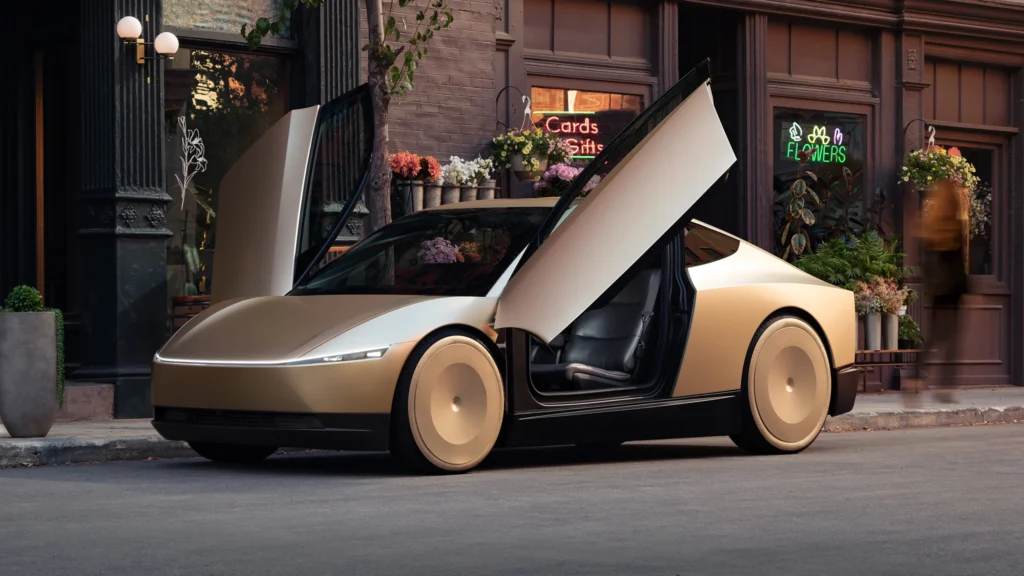Tesla has taken yet another bold step towards shaping the future of transportation with the unveiling of the Tesla Cybercab. Building on its cutting-edge technology and innovative designs, Tesla aims to revolutionize urban mobility through this electric, autonomous taxi service. But why the taxi industry, and how does the Cybercab stand to change the way we navigate cities?

Introduction to the Tesla Cybercab
Tesla’s Vision for the Future of Transport
Tesla’s ultimate goal is clear: create a sustainable, eco-friendly future where transportation is faster, safer, and more efficient. The Cybercab represents this vision by combining electric power with advanced autonomous driving technology, giving commuters a glimpse of what future city transportation could look like.
Why Tesla Chose the Taxi Industry
While Tesla is renowned for its electric cars and futuristic tech, it’s not surprising that the company would turn its attention to the taxi industry. With millions of taxis operating worldwide, transforming this sector could lead to enormous reductions in emissions and costs. The Cybercab is Tesla’s attempt to push urban transportation into a greener, autonomous future.
Key Features of the Tesla Cybercab
The Tesla Cybercab comes with several key features that set it apart from traditional taxis.
- All-Electric Powertrain and Sustainability
Like all Tesla vehicles, the Cybercab is powered by electricity, meaning it emits zero emissions during operation. This feature alone makes it a game-changer in the world of urban commuting, especially as cities globally strive to reduce their carbon footprint.
- Autonomous Driving Technology
What makes the Cybercab truly innovative is Tesla’s Autopilot and Full Self-Driving (FSD) capabilities. With FSD engaged, the Cybercab can autonomously navigate through city streets, pick up passengers, and deliver them to their destination without a human driver. This could significantly reduce the cost of rides and make city travel more accessible.
- Futuristic Design and Build Quality
The Cybercab takes design cues from the Cybertruck, with a sleek, robust exterior that can withstand the rigors of urban environments. Its interior is designed with comfort and space in mind, making it ideal for busy city commutes.

Environmental Impact of the Tesla Cybercab
One of the most significant aspects of the Cybercab is its potential to reduce pollution in cities.
- Reducing Carbon Footprint
As an all-electric vehicle, the Cybercab eliminates the need for fossil fuels, helping cities move closer to their carbon reduction targets. Every mile driven by a Cybercab represents a mile not powered by gasoline or diesel.
- Emission-Free Urban Commutes
Urban areas suffer from high levels of air pollution due to dense traffic. By replacing traditional taxis with Cybercabs, the air quality in major cities could improve dramatically, benefiting both the environment and public health.
Cybercab's Impact on Urban Transportation
- A Game-Changer for Public Transport
The introduction of the Cybercab could enhance public transportation systems by offering an eco-friendly alternative. With Tesla’s efficient software and autonomous driving technology, the Cybercab could complement or even replace existing taxi services in the future.
- Improving Accessibility for All
Tesla’s autonomous technology means that transportation could become more accessible for people who may not be able to drive, including the elderly and disabled individuals. A fleet of Cybercabs could offer them greater freedom and independence.
- Impact on Ride-Sharing Services
The Cybercab could also disrupt ride-sharing services like Uber and Lyft. With no drivers to pay and lower operational costs, Tesla’s autonomous taxis may offer cheaper and more efficient services in the near future.
Tesla's Autopilot and Full Self-Driving Capabilities
- Understanding Tesla’s FSD Technology
Tesla’s Full Self-Driving (FSD) system is constantly evolving. In the Cybercab, it uses advanced sensors, cameras, and artificial intelligence to navigate through traffic, make real-time decisions, and provide a seamless experience for passengers.
- How Autonomy Benefits Taxi Services
By removing the need for human drivers, Tesla can reduce the cost of taxi services, making it more affordable for passengers. It also minimizes the risks of human error, ensuring safer rides.
The Cybercab vs Traditional Taxis
- Cost-Effectiveness Over Time
While traditional taxis rely on gasoline or diesel, the Cybercab operates on electricity, significantly lowering fuel costs over time. Coupled with autonomous driving, this could lead to lower fares for customers.
- Comfort and Experience
The Cybercab promises a comfortable and quiet ride, thanks to Tesla’s focus on passenger experience. With features like air filtration systems, spacious interiors, and advanced climate control, it’s designed to enhance city travel.
How Tesla is Shaping the Future of Urban Mobility
- The Role of AI and Machine Learning
Tesla is integrating AI and machine learning into every aspect of the Cybercab. This technology allows the taxi to learn from its environment, continuously improving its performance.
- Building Smart Cities with Tesla Technology
Tesla envisions a future where Cybercabs operate within a larger ecosystem of smart cities. These cities could optimize traffic flow, reduce congestion, and create more sustainable environments for residents.
Conclusion: Tesla’s Bold Move into the Taxi Market
The unveiling of the Tesla Cybercab marks a significant shift in the world of urban transportation. With its combination of autonomous technology, electric power, and innovative design, Tesla is once again pushing the boundaries of what’s possible in the automotive industry. As cities continue to grow, the Cybercab could offer a cleaner, more efficient way to navigate urban environments.

